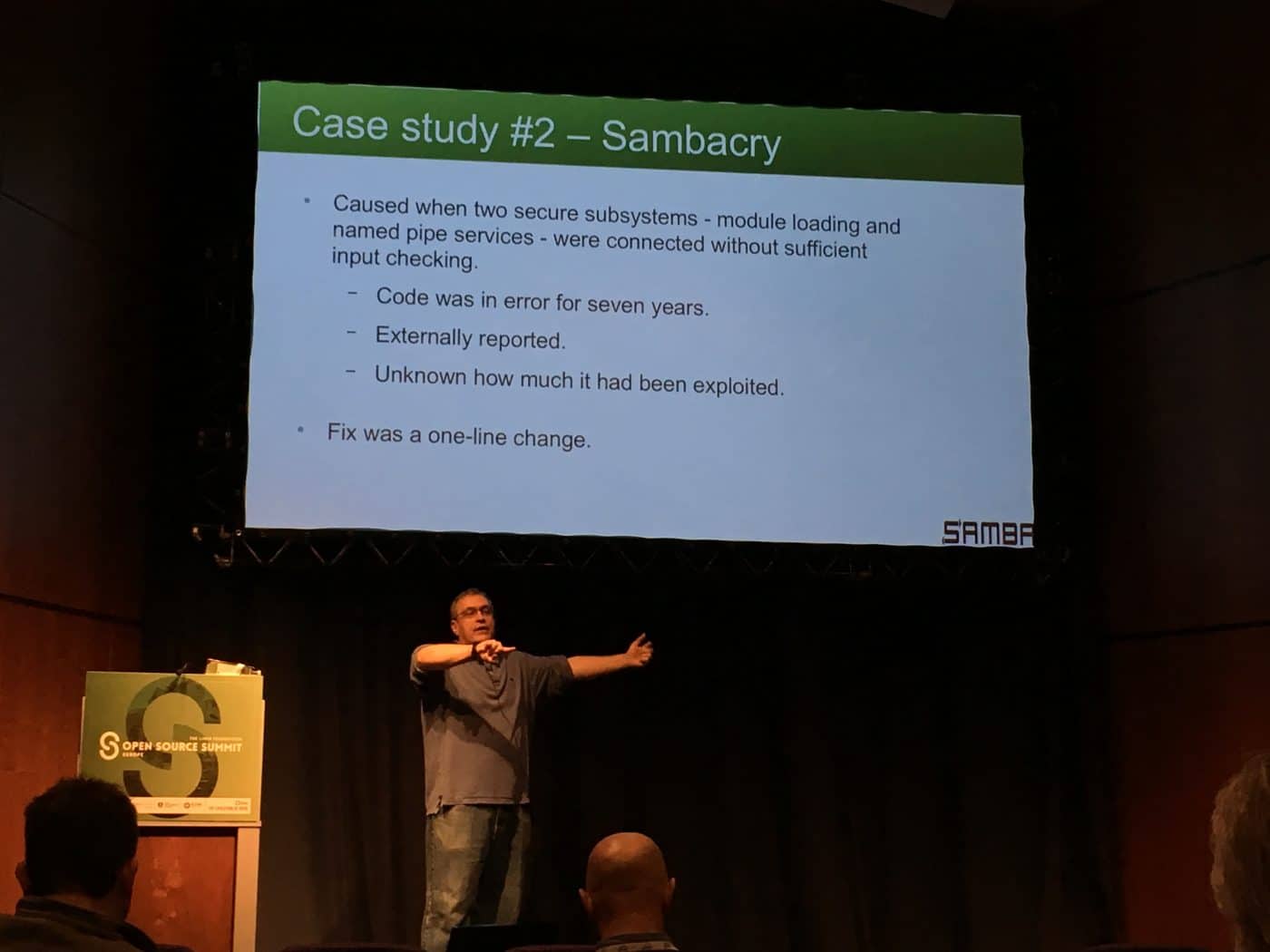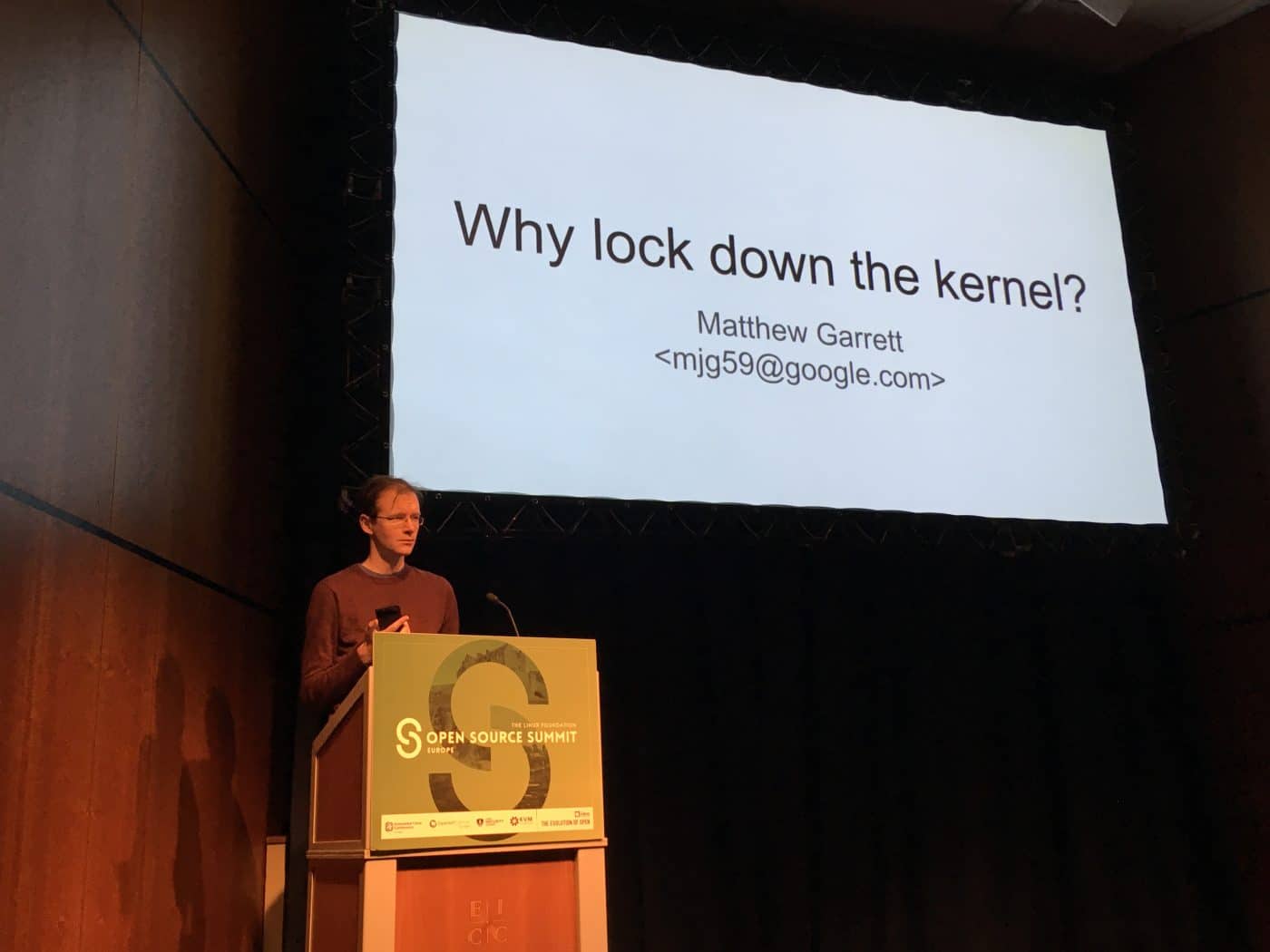Open Source Summit EU 2018
I recently attended Open Source Summit 2018 and the collocated Embedded Linux Conference and OpenIoT Summit in Edinburgh at the International Conference Centre. To kick start my blog and share my experience, I have written the following trip report. As this was my first tech conference, my hope is to encourage more people to attend their first conference.
Diversity and inclusion:
The first thing I noticed in the run up to the event and when I arrived, was how welcoming and inclusive the event organisers were. There is a code of conduct which spells out the traditional “don’t be a dick” policy for anybody whose common sense is not sufficient to interpret it correctly. Having a code of conduct makes it possible to enforce the rules. It’s a step which many tech communities have taken recently in order to disprove the nerd stereotype and embrace the diverse group of people who contribute to the open source community.
The event organisers went above and beyond to ensure the attendees would feel comfortable. The conference badges contained all of the information required to know whether to and how to approach people. The badges had our names and ‘badge flare’ was provided in the form of small badges with keywords of technologies and topics which interest us, for example ‘Linux’, ‘IOT’, ‘Embedded’ etc. These could be pinned to the lanyards of our conference badge. In addition to this, traffic light coloured stickers were available. These could indicate that you were open to people talking to you, would prefer to approach people yourself or were too busy to talk at this time. These stickers were available throughout the conference so you could switch them out depending on your current circumstances. These helped to give you the confidence to talk to people because you knew that they were available. Furthermore, stickers which indicated your preferred pronoun were also available. The event organisers seemed to have thought of everything to ensure the attendees would be comfortable and the chance of accidentally offending anybody or possibility of awkwardness was minimised.
First impressions:
First time attendees were well looked after. I attended the first time attendee breakfast at the beginning of the first day. It was an opportunity for first time attendees to meet with others who were in the same boat. Better yet, conference veterans and members of the Linux Foundation were there too. Initially I wasn’t feeling confident enough to butt into anybody’s conversation but I enjoyed the food. Shortly after I got there, Tim Pepper introduced himself to me which ultimately led this to be my most valuable session of the conference because I learned how to get the most out of a tech conference.
Tim is a cool guy. I had more questions for him than I could have expected, all of which he very kindly answered. The information and advice I got at the breakfast helped me to make the most out of the conference. It gave me the confidence to go and talk to people which made the conference a hugely enjoyable and educational experience. The best advice I got was to take advantage of the hallway track and just go ahead and butt in (politely of course) if there was something I had to contribute, the other attendees would not mind and it might well put faces to names of the people you talk to or see online.
The networking opportunities at a tech conference are probably even more valuable than the talks. I would be surprised if it wasn’t a regret of all first time attendees at any tech conference, that they didn’t speak to enough people and I probably didn’t speak to nearly enough myself. The conversations I did have, however, were all really valuable. I learned a huge amount and met many new interesting people.
The keynotes:
There were keynotes in the morning of every day, these were all very high quality. The highlights for me were Monday’s ‘The kernel report’ (Jonathan Corbet, lwn.net). Jonathan spoke about the spectre and meltdown vulnerabilities from his informed point of view. He also encouraged everybody to run the latest version of the kernel and spoke about the progress Linux has made since the ‘the good olde days’.
The Keynote ‘Astronomy with Gravitational Waves’ by Dr. Alexander Nitz who is a Gravitational-wave Researcher and lead developer of PyCBC, was one of the most interesting talks I attended. It was slightly different to the other talks because it was very scientific. I found it captivating, if you have a spare 20 minutes, I highly recommend you watch his talk.
Finally, the third keynote which particularly stood out was Open Source Game Design by Brenda Romero. Brenda designed a number of games, one of which consists of 50,000 hand made pieces. She then open sourced the design patterns. Later in the day, I overheard a conversation about Brenda’s talk while waiting to get into a talk. They said that what she was creating were not games but a work of art instead. Upon reflection I think they are both, the games she created are without doubt a work of art. However, they are also games. They have game mechanics and are in fact complete games which you can build yourself and play.
The talks:

In addition to the amazing keynotes, all of the talks I attended were very high quality. Each of them entertained and educated me in some way. My highlights were the following: ‘Handling Security Flaws in an open source project’ by Jeremy Allison who works for Google. The talk was not a Google talk though, instead the talk was about Samba. The talk detailed the three most severe vulnerabilities discovered in Samba so far. Jeremy also noted that everyone in the room was a bad person and should feel bad for not using PGP/GPG encrypted email. As a cyber security student, I was already aware of the vulnerabilities discussed in the talk. The insights Jeremy was able to give as a developer were very interesting. I especially enjoyed the defence of the C programming language and observation that memory-safe languages are not a panacea.

Another talk from a Google employee, ‘Why lockdown the Linux Kernel?’ by Matthew Garrett went into details of a set patches which put a barrier between root and the kernel. This is something that all of the Linux vendors and projects have added to their distributions individually. Linus will not allow the patches in the mainline Kernel at this time because he objects strongly to one of them. I believe the talk was unfortunately not recorded but the slides are available.
The third highlight was the talk by Greg Kroah-Heartman of the Linux Foundation, ‘Spectre, Meltdown and Linux’. This brings me to the only criticism I have of the conference. The popularity of this talk was severely underestimated. We filled out a schedule online using sched.com to give the organisers an idea of how popular the talks would be. 400 people had added this one to their schedules. The room Greg was given only fitted 200. I got there as early as possible to try to get in and I still had to stand at the back of the room, something I was happy to do for a talk of that calibre. I can’t help but feel like the talk probably should have been in the auditorium where the keynotes were.
To be fair, many people might have added the talk at the last minute and there were probably many like me, who added 6 talks in each session even though you can only attend 1. The talk itself was fantastic. Greg is an amazing speaker and he made a fairly complex topic easy to understand, enjoyable and relevant to everyone from seasoned developers to Linux users. If you have the chance to see Greg talk, I strongly suggest you take it. Sadly I have not been able to find a recording of the talk but once again the slides are available.
The sponsors:
The sponsors at the event were all very cool. Intel and Microsoft were diamond sponsors which is the highest tier. IBM, AWS, Red Hat and VMware as well as many other large and smaller companies were there. I spoke to everyone and in addition to learning more about their companies or products and telling them about my experience using their stuff, I picked up bags of merchandise. The highlights were of course the stickers and the clothing. I especially like my red hat, intel socks and very clever IBM shirt.
Of course for me personally there were a couple of sponsors which stood out. I have used AWS for a few years now, having started out by taking advantage of their free tier to host a couple of projects and to get to know the platform. I have since gotten to know AWS a little better and it is now my preferred platform for personal projects. The best things about talking to the folks at the AWS booth at Open Source Summit were that, even though this is a Linux conference, I had the chance to talk about my other favourite open source operating system, FreeBSD. Additionally, I learned about the student program which provides a limited amount of usage on AWS services for free.
I also learned about the OpenPOWER Foundation. In class, I recently learned about RISC-V which is an open instruction set architecture. Power is not quite as open as RISC-V at this time. However, it is the most open high performance CPU Architecture because RISC-V is aimed at embedded applications. One of the biggest plusses for open source advocates or security conscious Intel users like myself is that there is no management engine. There is of course some alternative to initialise the hardware and perform the same tasks. However, it is not as secretive. What surprised me about systems running Power is that the price is actually not prohibitive. The booth had leaflets showing the systems sold by raptors.com and the price is not much different to that which you would pay for an Intel system that is similarly high end.
The reception
It wouldn’t be a conference without a reception and there were in fact two. There was an all attendee reception which took place at the National Museum of Scotland on the first evening and an on-site reception on the second evening. The receptions were an excellent chance to talk to the attendees, network and make contacts. I managed to see about half of the museum while I was there, too. Soft drinks were free and we were given coupons for a couple of free beers or glasses of wine on our conference badges. So if you need a confidence boost to help you go socialise, it’s on the house. The on-site reception was combined with a showcase from some of the sponsors.
Conclusion:
In sum, I probably didn’t talk to nearly enough people but had an amazing time. I would recommend anybody interested or working with Linux or open source to attend. I got a student discount because I am currently at university. If you are eligible, you should definitely take advantage of the discount. I paid about 1/5 the cost of a standard attendee which made the conference even better value. There are too many things to share in detail here so I would definitely encourage you to try to go to a tech conference yourself.
Credits:
- Hero image taken by The Linux Foundation and used under the terms of the Creative Commons Attribution 2.0 Generic (CC BY 2.0) License.
- Tux logo used with permission from Larry Ewing.